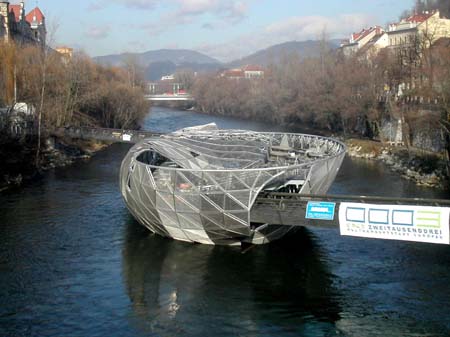グラーツGraz

Murinsel: Elvira Klamminger / A multicultural island arena was set up on River Mur according to plans. / by the New York artist and designer Vito Acconci, offering a cafe and rooms for events and performances.
グラーツという街を、ご存知だろうか?一度も聞いたことがない?そんな人の為に、2003 年「ヨーロッパの文化の首都」に選ばれたこの街について少し紹介しよう。まず、今回のこの「ヨーロッパの文化の首都」というタイトルは、Do you know Graz? No, never heard of? Well, I think I should tell you a few details about “Europe’s Capital of Culture” in 2003 then. For those who don’t know it – the title is an annual award from the European Union aimed at highlighting the EU’s many and varied cultures (and probably boosting tourist numbers…).欧州連合により贈られる、毎年恒例のアワードの名前。EU諸国の多種多様な文化にスポットを当てるのがこのアワードの目的だ(そしておそらく、旅行者の数の増大も含まれていることだろう)。
グラーツは、ヨーロッパの文化の首都として選ばれた最初の街。EUに加盟している15カ国の文化大臣によって選ばれた。オーストラリアの第2の都市であり、建都875周年の歴史がこの名誉に結びつき、それによってグラーツでの5000以上の文化的イベントが予定されている。
![]()
時として、オーストリアの隠れた「秘宝」と表現されるこの街。ヨーロッパ南東部への「出入り口」としての役割を果たすこの街は、ここ12ヶ月間の間に「ヨーロッパの文化の首都」という称号を得るために、あやゆる努力を重ねる。そして現在グラーツ当局や観光協会は、他の都市もグラーツのように、その街それぞれが持つお勧めスポットを見つけ、いつの日か、それがツアーリストマップに掲載されることを祈っているのである。
![]()
グラーツの街を知るには、歩いて回るのが一番だろう。歴史があり、中世の趣を感じさせるこの街は、中央ヨーロッパの中でも有数の昔ながらの風景が残された街で、1999 年には、ユネスコにより自然と文化の世界遺産として登録された。ロマンティックな路地が町中に巡り、南部のテイストが感じられるイタリア式の宮殿がある街。ゴシック調のダブルの螺旋階段、一度も侵略を受けずに残った要塞、365枚の窓がある城、反対周りに回る時計がある時計台…。見どころも満載だ。週末になれば、通りは多くの人々で賑わい、太陽の光が強くなってきた頃には、オープンカフェやレストランへと人が集まる。グラーツの人口は25万人。そのうちの20%が学生だ。そのため、この街は学生の街としての顔も持ち、アバンギャルドなアート、ジャズ祭、クラシックコンサート、オペラなどが一年を通じて行われている。
![]()
街としての認知度を高めただけではなく、「ヨーロッパの文化の首都」として、多くの革新も行ってきたグラーズの街。文化的、政治的、そして地理的条件においても、長続きする効果をもたらす流行を作り上げたい、というのがその目的だ。そのために5億ユーロ以上が投資され、新しく出来た現代美術センターや、ムアー川に浮かぶ浮島などに使われた。また今年には、「STYRIARTE」という、ニコラウス・ハノンコートを指揮者として迎える音楽祭、文化イベント「STEIRISCHER HERBST」、物語を取り上げたフェスティバルの「GRAZ ERZAHLT」、パペットショーのフェスティバル「LA STRADA」、オーストリアの映画祭「DIAGONALE」が、街の文化プログラムとして行われる予定。、THE SCHAUSPIELHAUS THEATRE、オペラハウス、博物館、ギャラリーももちろん、現代のグラーズの街がフィーチャーされる。
このように、イベントが盛り沢山のグラーズ。これらのイベントに行く用意はもうできているだろうか?
![]()
Graz Tourismus GesmbH
Herrengasse 16, A-8010 Graz, Wien
+43 1 316 80750
info@graztourismus.at
http://www.tiscover.at/graz/
![]()
Text: Christina Merl
Translation: Sachiko Kurashina
Graz is the first Austrian city that has been chosen as Cultural Capital of Europe by the ministers of culture of the fifteen EU member countries. The honour coincides with the 875th anniversary of Austria’s second-largest city and results in a unique cultural programme of more than 5,000 events.
![]()
Sometimes referred to as Austria’s “hidden gem”, the provincial capital of Styria has long lived in the shadow of more famous Austrian towns such as Salzburg or Innsbruck. However, Austria’s “gateway” to the southeast of Europe has been gearing up over the past twelve months to get the title of “Europe’s Capital of Culture” in 2003, following Salamanca (Spain) and Bruges (Belgium). Certainly, authorities and tourist boards in Graz hope that the rest of the world will soon discover the charms of their city and that it will be on the tourist map in the future.
![]()
I think you can best discover Graz by walking around. The old, pedestrianised medieval city centre is one of the best preserved city centres in central Europe and was declared cultural world heritage by the Unesco in 1999. It offers you romantic narrow streets and Italian-style palazzi with southern flair. Graz is many things at the same time, you know – a Gothic double-spiral staircase; a fortification that was never conquered but blown up; a chateau with 365 windows; a clock tower that’s got time the “wrong way round” etc. However, Graz is far from being a “museum”. Quite the contrary – at weekends the narrow streets are bustling and at the first hint of sunshine, everyone herds for the numerous outdoor cafe and restaurants. One fifth of its 250,000 inhabitants being students, Graz is a well-known university city and hosts avant guard arts and jazz festivals as well as classical concerts and operas throughout the year.
![]()
As well as bringing recognition, becoming a European Capital of Culture also means plenty of renovation. Graz wants to set trends that will have a lasting effect on the cultural, political and geographical situation. Giant cranes have dominated the skyline with more than 50 million euros being spent on improvements, including a new ultra modern arts centre and a floating island on River Mur. In fact, contemporary architecture has set some exciting trends in Graz. They indicate the numerous cultural activities, including the “Styriarte” music festival with star conductor Nikolaus Harnoncourt as its figurehead; the “Steirischer Herbst” as a checkpoint of cultural trends; the “Graz erzahlt” story-telling festival; the “La Strada” festival of street and puppet theatre; the Austrian film festival “Diagonale”; the Schauspielhaus theatre; and the Opera house; museums; galleries – all this is contemporary Graz and will feature prominently in the city’s cultural programme for the year 2003.
Well then, ready for Graz?!
![]()
Graz Tourismus GesmbH
Herrengasse 16, A-8010 Graz, Wien
+43 1 316 80750
info@graztourismus.at
http://www.tiscover.at/graz/
![]()
Text: Christina MerlGraz旅游公司
地址:Herrengasse 16, A-8010 Graz, Wien
电话:+43 1 316 80750
info@graztourismus.at
http://www.tiscover.at/graz
